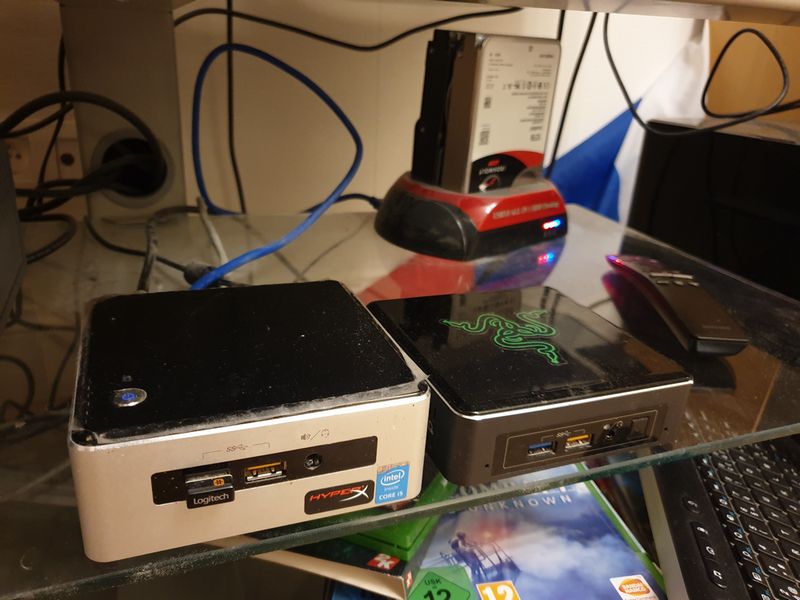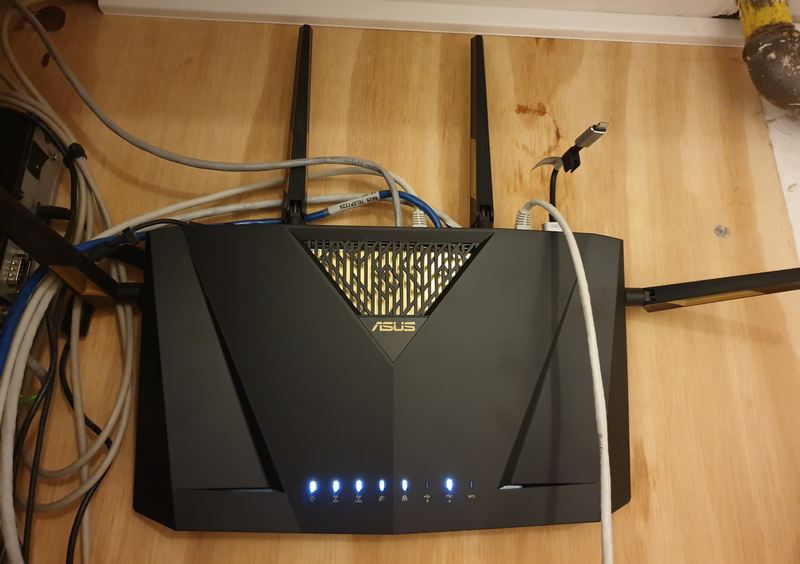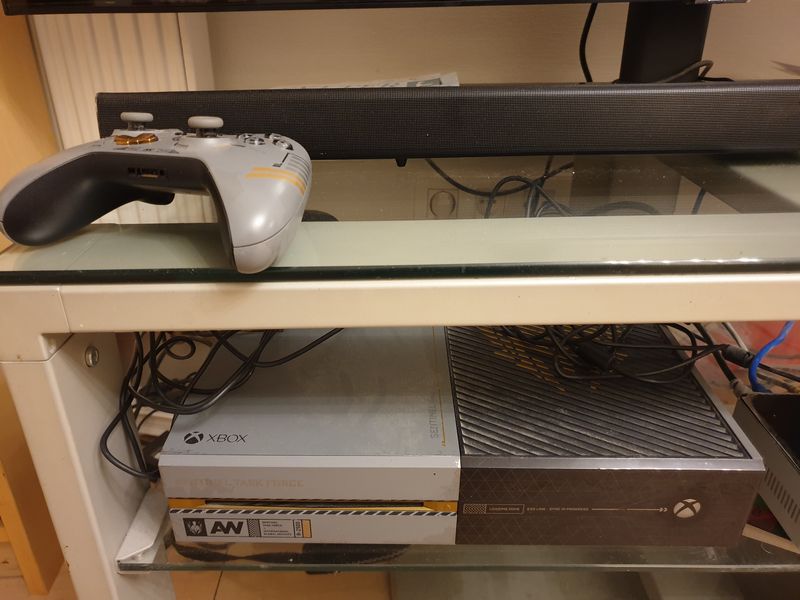
Intel NUC mini PCs don't need to be presented to anyone. We wrote about it on the Intel blog many times, and more recently, we held a NUC contest with it as the main prize. And now about him again, now at home. Here is a first-person story from a longtime friend of the Intel blog editorial about his personal experience of using the Intel NUC as a base for a home media system.
So, the task: to sit at home, watch video, photos on the TV screen, listen to music from local libraries and, less commonly, streaming services.
What you do n’t need: view on-air / cable channels. Many years ago, we realized that we were not watching TV broadcasts on a regular basis and refused the cable. But there is no broadcasting TV in Belgium, where the case is taking place. In some rare cases, when necessary, broadcasts of almost any channel can be found one way or another on the network.
Hardware configuration until recent changes
First of all, the home server, aka HTPC. Built on the basis of a small Intel NUC computer, the NUC5i5RYH model, not the newest, has been operating for 4 years. The dual-core Intel Core i5 processor is more than enough for my tasks; i3 would be enough. The i7 would be hotter, noisier and more expensive without any benefits. NUC is always on. No need to turn off.
16 GB of memory are stuck in the server. Eight would be enough, but I love when there is a lot of memory.
For the system and applications installed 500 GB SATA SSD Samsung EVO 850. Busy no more than 30%, so that you could get by with a 256 GB drive.
An unnamed Chinese docking station with two 3.5-inch hard drives is connected via USB 3.0. It contains disks of 4 and 12 terabytes, they store media libraries. The 12 TB option is the new helium Seagate Iron Wolf NAS, 4 TB older, also Seagate, some kind of semi-server model, advertised as reliable, for 4 years it really did not break.
NUC5i5RYH is a NUC model with an additional 2.5-inch SATA drive bay. I thought that an additional disk might be needed for the server. As a result, taking into account the external dock, it was not useful. It was possible to take a flat low-profile version, Intel also has such. They are prettier.
Intel NUC has a built-in infrared port and can be controlled using a standard infrared remote control for a computer from Microsoft.
For more complex operations, there is a small wireless keyboard with an integrated Logitech K400 touchpad.
By the way, I generally like NUC as an option for a home PC. His son is the same, a newer and low-profile model. He even manages to play Overwatch on his integrated schedule. We are strict parents who do not approve of pampering. Therefore, although the child as a whole was not stingy with the computer, options with separate graphics were deliberately excluded.

On the left is the server, on the right, for comparison, the low-profile version of the NUC that the son uses, on the back on the right is the dock with disks
NUC plugs a gigabit cable directly into the Asus RT-AX88U router. A router of the previous model, RT-AC88U, is connected to this router in the attic of a house by cable, in slave mode via Asus AiMesh. AiMesh provides transparent roaming in home Wi-Fi networks, this is an interesting separate topic for discussion, but it has no direct relation to the organization of a media library.

Main router
The XBox One game console, to it the Kinect controller with a small plastic bracket from Hama, to install it on the top of the TV.

Xbox one
TV Samsung UE40D6530. 40 inches, Full HD, there is Wi-Fi and Smart TV, but the old, the year before last generation. Smart chips are annoyingly slow and therefore not used. 4 HDMI inputs. One of the inputs is occupied by a Microsoft Miracast adapter to connect computers over the air. The TV does not support Miracast directly.
Soundbar Samsung HW-F550. I was too lazy to pull wires through the room for multi-channel sound and limited myself to 2.1. You can connect to it via HDMI (passthrough), optics, analogue or Bluetooth. Able to play music directly from a usb flash drive, but I do not use it.

Soundbar and Yandex Station
Old Logitech Harmony One universal infrared remote control.

Harmony one
Video table made of metal and glass from Ikea, extension cord with a bunch of outlets, wires.
Connection
The equipment is connected to the TV through the soundbar in the manner described in the default instructions. Later, I realized that I hadn’t studied the issue in detail, it could have been done much more conveniently.
So: the HDMI output from the computer is stuck into the soundbar, and the output of the soundbar to the TV, HDMI 1. The soundbar passes the video stream through it through the TV, and the sound leaves and plays it itself.
For XBox, there is no free HDMI input on the soundbar. It is connected to the HDMI 2 input of the TV and an optical cable to the soundbar. The presence of something at the other end of the optics XBox sees and he begins to dump the sound there.
Software part
Windows 10 Pro N is installed on the server; this is a version of Windows without additional components installed. All necessary needs to be put separately. Geek's dream, after Linux, of course. The server is physically standing on the table under the TV, it works both as a server and as an HTPC at the same time. The load is small, responsibility in case of failure, too, so this is more than enough.
SQL Server, IIS, Team Foundation Server are spinning on the server, folders are shared. But at boot, it automatically enters the standard (non-admin!) Account without a password and downloads the Kodi media shell, the former XBMC. Kodi indexes media library folders, downloads metadata from external services: names, information, covers, and displays them beautifully on the screen. Able to show videos from youtube, although not in the most convenient way. It supports plugins of many other services. Understands Microsoft Remote Control Commands.
In addition to Kodi, Caliber, which provides the home network library service, is automatically loaded under the same account.
Control
The Logitech Harmony One remote control is connected to the computer and allows you to download profiles of the necessary devices, after which it can send their IR commands. Logitech has a huge network library of profiles, there is almost everything. If something is missing, then there is an infrared receiver on the remote control, it can be trained manually from the native remote control. But I have never had to do this.
On the remote control, the profiles of the TV, soundbar, XBox (allows you to only turn on and off) and the Microsoft remote control for the computer are loaded. Harmony lets you create scripts in Logitech Activities terminology by grouping multiple devices. For example: the scenario “We watch media PC”: Turn off the XBox (if it’s turned on), turn on the TV (if it’s turned off), turn on the soundbar (if it’s turned off), try (more on that later) to turn on the soundbar to the desired input, the volume control is controlled by the soundbar commands, everything else It is controlled on the computer by Microsoft remote control commands. In addition to this scenario, just one more is needed: “We play in XBox”.
This covers all the simplest scenarios. For more complex computer settings, a keyboard is taken. It can, of course, be controlled by video as well, but this is superfluous.
Disadvantages of the solution
They are associated with management.
First of all, the infrared remote control has no feedback. He judges the state of the controlled equipment on the basis of the assumption of its initial status (off) and assuming that all IR commands were received and executed correctly. Both may be wrong. Transferring several commands to different devices takes three to four seconds of time, a remote casually thrown on the sofa before the end of the transfer can sometimes lead to some commands not reaching. Given the order of the commands, this means that the soundbar will either not be turned on or will not switch to the desired input (HDMI or optical).
A more serious problem: there are no commands directly connecting the required input either on the native soundbar remote control or in the remote control profile. Perhaps this device does not have them at all. Only by sequential switching. This makes reliable inclusion of the desired input impossible. If someone switched the input manually, for example, connected the phone via Bluetooth to listen to music, this breaks the entire serial bust with the remote control.
This leads to the fact that once or twice a week, when you click on "watch video", the TV displays a black screen. It is necessary to solve the problem by switching the remote control from the scenario mode (activity) to the device mode (device), after which the device (usually the soundbar) switches to the desired state. It turns out somehow inelegantly. The wife, who does not want to delve into the settings of the equipment, in this case says “it didn’t hurt, I wanted to” and turns on the laptop. The nine-year-old daughter, who does not have her own laptop, copes with the problem, which is interesting, somehow.
Until recently, they lived like this, the situation was considered acceptable.
Changes
Recently I decided to replace the TV with a larger one. I chose the 55-inch Samsung QE55Q70R. He is 4K. Supports Miracast, so a separate adapter is no longer needed.
The story of mechanical problems associated with installing a new large screen on an old table, I will omit, they are solved with a screwdriver and a couple of strong words.
Connecting a new TV in the same way as the old one will not work, because:
- The new TV has a new remote. It is very convenient, but it does not use infrared radiation, but bluetooth. It is impossible to imitate it with the good old Harmony One, I don’t want to produce remotes.
- An old soundbar cannot pass a 4K signal through a TV. Can not. The prospect of buying a new expensive soundbar loomed, despite the fact that the sound of the old suits me.
There was a solution. You need to connect not a source-soundbar-TV, but a source-TV-soundbar. Samsung's HDMI input labeled ARC can act as an audio output, forwarding the incoming audio signal and sending control commands to compatible devices. It supports on-off and, of course, volume control. Now 4K goes directly to the TV, bypassing the soundbar, you do not need to buy a new one. And the remote control for the soundbar is not needed at all, because it is always turned on at the same input and is controlled directly by the TV. I must say that this solution was also available for the old TV, and if I was too lazy to investigate the issue and experiment with the connections, the black screen problem would be solved much earlier.
But that's not all. The remote control is needed to control the computer player (Kodi). How to get rid of the remote control is not clear. The idea comes: is it possible to get rid of Kodi and organize convenient streaming of everything directly to the TV? Convenient is the key word here. It was possible to make it inconvenient with an old TV. But the new one has a more powerful processor, nothing slows down, you can try.
The first thing that comes to mind: DLNA. DLNA streaming can be organized using Windows tools, but on Windows N these tools are not installed by default, in addition, not all formats are supported, it can be bad with audio tracks and subtitles. I look further and find out that the DLNA server is built directly into Kodi. I turn on, the TV immediately sees it. I choose in the TV menu, the DLNA client interface is extremely ascetic, but it's not so bad. The trouble is that the first episode included does not have an English track. It immediately becomes clear why. DTS tracks Kodi does not transmit. Let's go further.
The network is advised to use Plex as a media server. Supports its native network protocol and DLNA too. I register, download, set. Clean server, web-only interface and clients. I start scanning libraries, it takes a decent time. When scanning the library sometimes errors occur, some films are not recognized correctly, you can fix them manually through the web interface. This also happened on Kodi. While scanning, I turn on DLNA and, out of sheer curiosity, I find out what Plex has for the clients and what systems they have for. Surprise - they are for Samsung TVs. I put it from my native Samsung repository, connect, and here it feels good. Everything is beautiful, information, covers, search, plays in the original format, all tracks and subtitles in place.
Additional feature: Plex allows you to make the library accessible not only to any number of clients within the home network, but also to stream to the outside. Unless, of course, it’s scary to show the world what exactly lies in this library.
Conclusion: I’ll use Plex, the computer will become a clean server, I will remove Kodi from startup, in the future I’m demolishing it, Harmony One is retiring for a long time. You can live, and live well.
PS: And recently, Yandex station with Alice was added to the system. Compatible with new Samsung TVs, but awry. After successful pairing, it turns on and off once. It seems to be able to switch channels, but I do not have them. Connects via HDMI without any problems.